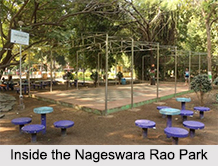 Nageswara Rao Park is situated in Mylapore in the city of Chennai in Tamil Nadu. The park covers an area of almost 4 acres of land. It also has a play ground for the children visiting the park. Nageswara Rao Park is maintained by the Sundaram Finance. People visit the park for morning walks and also for evening strolls. A badminton court has also been made.
Nageswara Rao Park is situated in Mylapore in the city of Chennai in Tamil Nadu. The park covers an area of almost 4 acres of land. It also has a play ground for the children visiting the park. Nageswara Rao Park is maintained by the Sundaram Finance. People visit the park for morning walks and also for evening strolls. A badminton court has also been made.
History of Nageswara Rao Park
Nageswara Rao Park was established in the year 1940. Earlier it was developed in a small area on the Luz Church Road. Later more land was donated by Aravamadhu Iyengar, Ramayee Ammal, V. Kumaraswamy Raja, M. Nainappa Mudaliyar; then the park was slowly expanded. In the year 1996 the park went into the hands of the Chennai Corporation and has been maintained by them since then; the park was then redeveloped by them.
It was Nageswara Rao, founder of the neighbouring Amrutanjan factory, who convinced the local residents to develop the area near the park when the Aaratha kuttai pond began to dry up. The park has been named after him.
Flora in Nageswara Rao Park
The park is rich in flora and houses varieties of trees like Cassia fistula, Lapostromea, Tabulia and foliage trees like Neem, Ficus religeosa, Pungam, Thespesia and Palms. It also has several ornamental and medicinal plants like Copper pod, Cassia sp., Tabubia, Ixora sp. and Enterolobium saman.
Project in Nageswara Rao Park
In the year 2009, a project was started by Sundaram Finance to procure manure from the waste products of the park. For this, a composting yard with three pits was established at the end of the park. The waste products of the park were collected from the bins and then converted into compost.
Visiting Information to Nageswara Rao Park
Nearest railway station of this park is Chennai Egmore Railway Station. Nearby airport is Chennai Airport to reach the place.



















